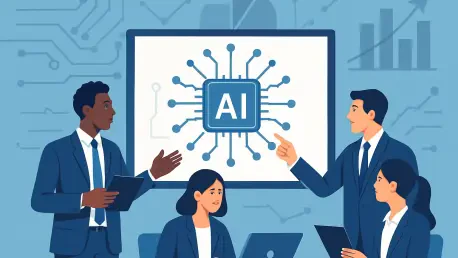In the fast-paced digital arena of 2025, artificial intelligence (AI) has become the linchpin of competitive advantage, with a staggering 92% of Chief Information Officers integrating AI into their strategies, according to Gartner. Yet, beneath this widespread adoption lies a sobering reality: a significant number of these initiatives risk failure without proper groundwork. Picture a multinational corporation investing millions in AI only to stumble over outdated infrastructure or skeptical employees. This scenario isn’t just a cautionary tale—it’s a common pitfall for businesses racing to keep up. What separates the leaders from the laggards in this technological race? The answer lies in understanding and achieving true AI readiness.
The importance of AI readiness cannot be overstated in an era where innovation dictates market survival. It’s not merely about deploying cutting-edge tools; it’s about transforming an entire organization to harness AI’s potential for efficiency, customer satisfaction, and growth. Failing to prepare means risking wasted resources or, worse, falling behind competitors who have mastered this shift. This exploration delves into the critical components of AI readiness, blending expert insights, real-world examples, and practical steps to illuminate the path forward for businesses aiming to thrive in this transformative landscape.
Unlocking AI’s Potential: Is Your Business Prepared?
The journey to AI readiness begins with recognizing that AI is no longer a futuristic concept but a present-day imperative. Industries from retail to healthcare are being reshaped by algorithms that predict trends, automate processes, and personalize experiences at unprecedented scales. However, the challenge isn’t just adopting AI; it’s ensuring that the foundation—be it technology or mindset—is robust enough to support it. Many organizations grapple with fragmented systems or data silos that hinder progress, revealing a gap between ambition and execution.
This gap often stems from underestimating the complexity of AI integration. It’s not enough to purchase software or hire data scientists. A holistic approach is required, one that aligns infrastructure with strategic goals and prepares employees for a collaborative future with intelligent systems. As Gartner warns, without AI-ready data and systems, a majority of projects could falter by 2026, underscoring the urgency for businesses to act decisively now.
The Urgency of AI Readiness in Today’s Market
Competitive pressures in 2025 leave no room for hesitation when it comes to AI adoption. Customer expectations have soared, demanding instant, tailored solutions that only AI can deliver at scale. Meanwhile, rivals who leverage AI for operational efficiency or predictive analytics gain a distinct edge, pushing laggards to the sidelines. The stakes are high: ignoring AI readiness isn’t just a missed opportunity—it’s a direct threat to long-term viability.
Beyond market dynamics, internal challenges add to the urgency. Disjointed data practices or a workforce resistant to change can derail even the most promising AI initiatives. Statistics paint a stark picture, with research indicating that cultural and data-related barriers often lead to costly missteps. Addressing these issues head-on is essential for any organization aiming to turn AI from a buzzword into a business driver.
Building Blocks of AI Readiness: Key Foundations
True AI readiness hinges on four interconnected pillars that collectively support sustainable integration. First, cloud infrastructure must be modernized to handle AI’s intensive demands, such as generative models or real-time analytics. Using frameworks like the Azure Well-Architected Framework helps ensure scalability and security, avoiding the pitfalls of outdated migration tactics that fail to optimize for AI workloads.
Second, cultural alignment plays a pivotal role in adoption. With only 23% of organizations providing formal AI training, as per ADAPT research, resistance remains a barrier. A case study from Brennan shows how service desk staff transformed from skeptics to advocates by viewing AI as a mentor, a shift driven by targeted education and leadership support. This highlights the need to foster trust and understanding across all levels.
Third, data sovereignty demands attention amid tightening privacy regulations. Balancing compliance with innovation requires transparent data handling and hybrid models, as seen in Microsoft’s localized Azure regions that cater to regional laws while maintaining global reach. Lastly, AI itself can aid readiness, with tools like Microsoft Copilot accelerating development processes, provided strict governance ensures meaningful outcomes over superficial results.
Expert Perspectives: What Leaders Say About AI Readiness
Insights from industry authorities reinforce the critical nature of preparation in AI endeavors. Gartner’s projections highlight that data unpreparedness could doom many projects by next year, a warning echoed across sectors. Meanwhile, ADAPT’s findings on training gaps—only a small fraction of companies mandate AI education—point to a human challenge that technology alone cannot solve. These statistics ground the discussion in hard realities facing today’s businesses.
Real-world voices add depth to the data. Brennan’s experience, where frontline workers embraced AI after reframing it as a supportive tool, illustrates the power of perspective in overcoming fear. Such stories, combined with expert analyses, reveal a dual focus: technical readiness must go hand-in-hand with human empowerment to unlock AI’s full potential. This blend of evidence and experience offers a comprehensive view of the readiness landscape.
Actionable Strategies to Achieve AI Readiness Now
Transforming insight into results requires a clear, actionable roadmap for AI readiness. Start by auditing cloud infrastructure using established frameworks to ensure it supports AI workloads with robust scalability and security. Prioritizing clean, accessible data sets the stage for effective implementation, preventing bottlenecks that could stall progress.
Next, invest in cultural transformation through tailored training programs for all staff levels. Appointing change champions and leveraging collaboration tools like Microsoft Teams can build confidence and foster a positive attitude toward AI. Additionally, prioritize data governance by mapping data locations and adopting hybrid solutions to meet compliance needs without stifling innovation. Finally, integrate AI tools like GitHub Copilot to streamline workflows, ensuring strict oversight to align outputs with business objectives. These steps provide a practical foundation for navigating the complexities of AI adoption.
Looking back, the journey to AI readiness demanded a blend of strategic foresight and tactical execution. Businesses that tackled this challenge head-on discovered that success hinged on integrating robust infrastructure, nurturing a receptive culture, and maintaining rigorous governance. Reflecting on those efforts, the path forward became clearer: organizations needed to continuously adapt by investing in scalable systems, upskilling their workforce, and staying ahead of regulatory shifts. The lessons learned paved the way for sustained innovation, ensuring that AI remained a powerful ally in navigating an ever-evolving digital landscape.









